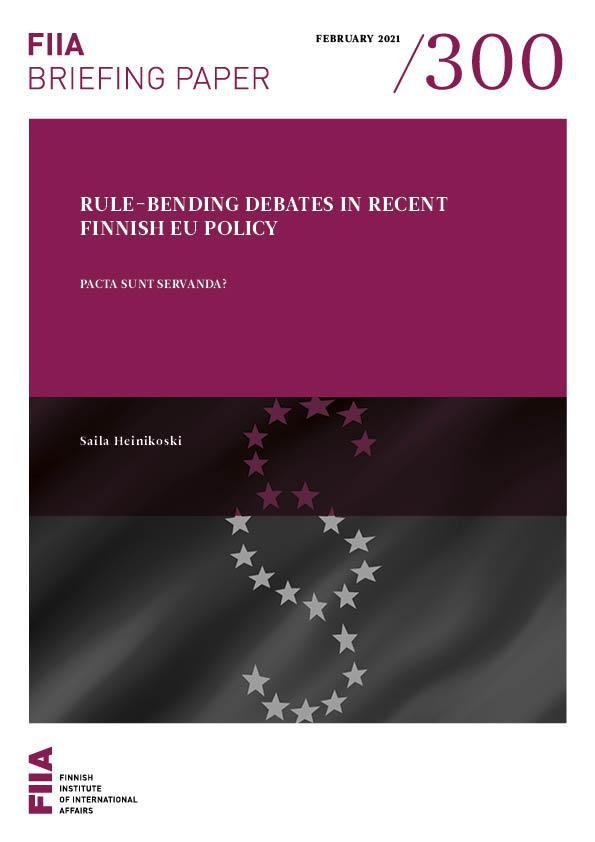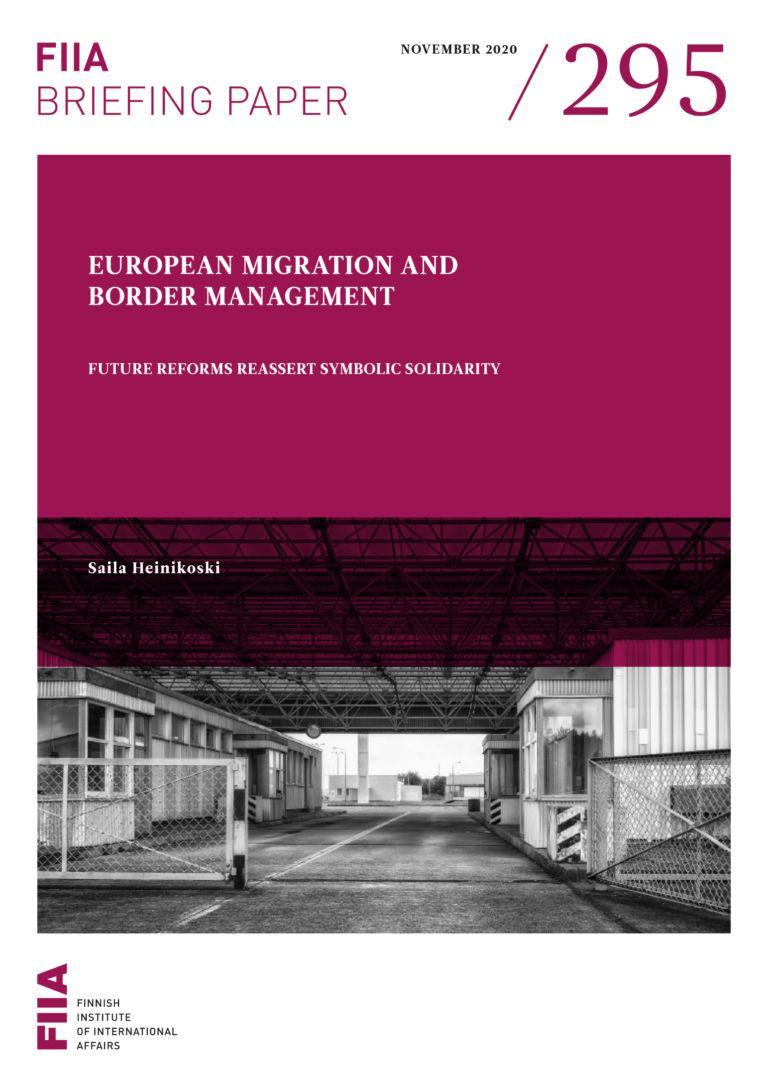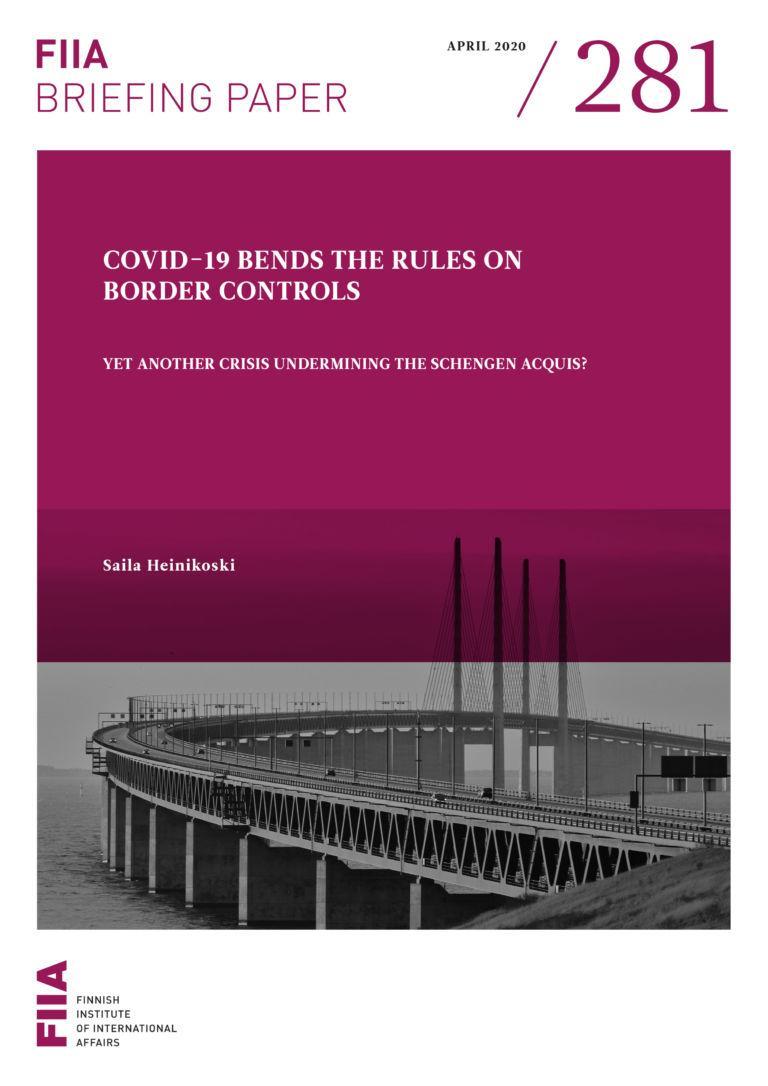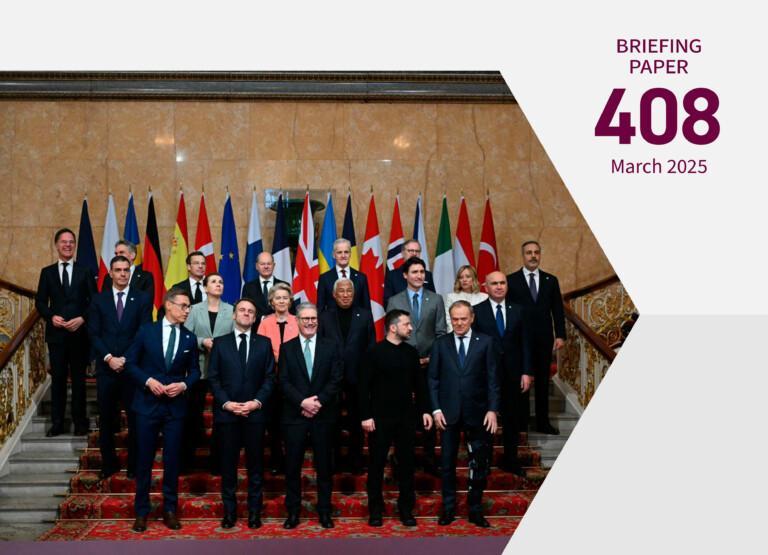
- The Finnish EU policy line has traditionally been adaptable and compromise-seeking, but recent examples related to the rule-bending of EU law reveal some new tendencies.
- Finland has stood out from the European mainstream in several cases that relate to the rule-bending of EU law in three different ways: rule-bending by others, collective rule-bending, and its own rule-bending.
- First, intervening in rule-bending by others has found support in Finnish EU policy. Finland prioritized the rule of law in its 2019 Council presidency, as well as in the Government Report on EU policy published on 28 January 2021.
- Second, alleged collective rule-bending seems to be linked to the threat of federalism. In negotiations on the recovery and resilience facility in 2020, there was a wide domestic debate on whether the result was consistent with the traditional interpretation of EU treaties.
- Third, Finland’s own rule-bending of the Schengen Border Code’s six-month limit for internal border controls during the Covid-19 crisis seems to have been quietly accepted, with the Interior Minister acknowledging the existence of an “illegal state of affairs”.
Introduction
Finland has been an EU member for 26 years. Membership divided the major parties before accession although the consultative referendum in 1994 was approved with a majority (56.9%), but EU affairs attracted little public attention post-accession. Ostensibly, over time, all political parties chose to accept the new state of affairs and EU policy remained relatively non-politicised for almost 15 years. The first time that EU issues became a major electoral topic was in the 2011 parliamentary election, where the Finns Party became the third largest party with their electoral pledge not to provide more financial assistance for other Eurozone members. That pledge also kept the party out of the government and made the party that lost many voters to the Finns, the Social Democrats (SDP), pursue a policy whereby Finland was the only country to demand collateral from Greece in exchange for the bailout package. EU policy debate has remained higher on the political agenda ever since.
Finland has actively participated in most EU policy projects, including those of differentiated integration (DI), where member states have joined diverse cooperation arrangements at a different pace and to a varied extent.[1] The last major division in DI matters took place in the 1990s, when the Centre Party opposed Finnish membership of the Eurozone. However, Finland adopted the euro and other major differentiated integration projects after that. The ease of participation in Finland may also be related to the fact that the Finnish parliament is particularly involved in EU matters: parliament grants a political mandate for the government in policy matters belonging to its competence. The Finnish stance on EU proposals is in most cases determined in the Grand Committee of the Finnish Parliament, with representatives from all parliamentary parties. This alone can make it more difficult to politicise EU affairs, since the parliamentary committees provide the mandate for the Finnish government in EU negotiations. However, some recent changes can be observed in EU policy, where the Finns Party in particular has changed the dynamics in the committees by questioning EU policy initiatives and even the entire EU membership at times.
This Briefing Paper looks at contemporary Finnish EU policy from the perspective of rule-bending in different policy fields. Three recent examples related to the topic are discussed. Firstly, Finland has pushed strongly when it comes to intervening in rule-bending by others in the rule of law context, which was presented as the first priority during the Finnish 2019 Council presidency, and in the government white paper on the EU published in January 2021. Secondly, there was a wide debate on alleged collective rule-bending with regard to EU treaties in summer 2020 concerning the financing of the recovery and resilience facility through market borrowing by the European Commission (guaranteed by the EU budget and hence ultimately member states). Lastly, Finland is unique in its ongoing own rule-bending of the Schengen Borders Code (SBC): Finland is the only EU state to continue Covid-19-related internal border controls beyond the deadline provided in the SBC. This rule-bending is also acknowledged in the Finnish government. For example, Minister of the Interior Maria Ohisalo admitted in a televised interview on Uutisextra on 7 November 2020 that “we have an illegal state of affairs” with regard to the prolonged internal border controls.
The table below illustrates the key contents of this Briefing Paper. The following sections will be devoted to each of the three cases and how the alleged rule-bending of EU law was discussed in each case. The rule of law debate will be discussed first, followed by approaches to the recovery and resilience facility, and border management. After that, brief conclusions on the contemporary picture of EU law rule-bending in the Finnish political debate are provided.
Table 1. Alleged rule-bending of EU law in Finnish political debates.
|
|
Example |
Policy field |
Domestic approach |
Alleged threats related to rule-bending |
|
Rule-bending by others |
Rule of law mechanism |
Democracy and values |
Approval to intervene |
Disuniting EU |
|
Collective rule-bending |
Recovery and resilience facility |
Resource allocation |
Criticism towards accepting |
Federalist EU |
|
Own rule-bending |
6-month limit on internal border control exceeded |
Free movement of EU citizens |
Approval to ignore |
Infringement procedure (not considered likely) |
Rule-bending by others addressed with the rule of law mechanism
The rule of law is linked to the EU Treaties (Article 2 of the Treaty on European Union) and breaching it is obviously considered a very serious violation of EU law. The current legal options available for intervening in cases of rule of law violations, such as that provided by Article 7 of the Treaty on European Union or EU Court rulings, have not turned out to be effective in intervening in breaches of the rule of law. In Finland, the issue has also been discussed as a matter relating to the EU’s fundamental values.
The rule of law appeared high on the agenda of the Finnish EU Council presidency during the second half of 2019. In the actual presidency programme, the rule of law was the first priority whereas in the programme of the government of Antti Rinne adopted just before the presidency, the main priority was the EU as a global climate leader. The presidency objective was clearly stated in the programme: “The aim is to set up a well-balanced and effective mechanism tying EU funding to compliance with the rule of law”.[2] This was indeed what Finland did in its first proposal on the multiannual financial framework presented in December 2019, which was in line with the Commission’s 2018 proposal concerning the Rule of Law Mechanism. When presenting the Finnish presidency programme in the European Parliament on 17 July 2019, Prime Minister Rinne also outlined why it was important to intervene in non-compliance with the rule of law: “Respect for the rule of law is not only a matter of protecting the rights of our citizens. It is also a matter of the proper functioning and credibility of the European Union.”[3] Ensuring compliance with the rule of law thus seemed to be important for the entire existence of the Union.
Similar tones were adopted when presenting the presidency programme in the Finnish parliament, and no party formally objected to tackling rule-bending and linking the rule of law to EU funding. This was also the issue that Finland emphasised as a success after the compromise on the Rule of Law Mechanism linked to EU funding in July 2020. The mechanism was equally praised by other parliamentary parties when Prime Minister Sanna Marin presented her announcement on the multiannual financial framework and the recovery package on 9 September 2020. The only party that has not placed the Rule of Law Mechanism high on the agenda is the Finns Party. In the debate, however, they mainly downplayed the importance of the mechanism and focused on other issues, such as what they considered to be a poor result, rather than criticising the Rule of Law Mechanism as such.
What EU scholarly literature calls a permissive consensus,[4] namely the domestic support for a particular policy field, seems to prevail somewhat in this context. It is also logical in the sense that the mechanism was considered to relate mainly to the actions of Hungary and Poland, and hence most Finnish parties had no interest in opposing it. Nevertheless, some individual Finns Party members have criticised other parties intervening in the affairs of Poland and Hungary. It is also expected that for Finnish voters, the issue is mainly supported, as also witnessed in recent Eurobarometer surveys: the spring 2019 survey revealed that Finnish respondents ranked the importance of the rule of law highest among all national respondents, with a third placing it among the top three values of the Union. This may explain why it may feel irrational to strongly politicise this particular issue. Furthermore, it is much easier to politicise the budget result and argue that it was either sub-optimal for Finnish taxpayers or not in compliance with EU treaties.
In addition to Finland, other member states have also supported the Rule of Law Mechanism as well as more effective and more functional avenues for addressing violations of the rule of law in Poland and Hungary. In this regard, Finnish EU policy does not differ that much from the key reference countries and allies. Since Finland was able to propose the first compromise on the multiannual financial framework (MFF), it was also possible to uphold the importance of the Rule of Law Mechanism attached to it. In retrospect, the rule of law promotion may even have changed the Finnish compromise-seeking image into a more uncompromising one, given the known sharp divisions among member states over the issue. In their EU policy white paper, the Finnish government also prioritized the rule of law as a cornerstone of the Union, stating that the “EU’s rule of law instruments should be developed further and used appropriately”.[5]
Alleged collective rule-bending in the recovery and resilience facility
Another topic where issues related to rule-bending were high on the Finnish political agenda followed the compromise agreement on the recovery and resilience facility reached in the July 2020 European Council. In this case, many opposition politicians questioned whether the facility complies with the so-called no-bailout clause provided in Article 125 of the Treaty on the Functioning of the European Union (TFEU), which states that “a Member State shall not be liable for or assume the commitments of central governments, regional, local or other public authorities, other bodies governed by public law, or public under-takings of another Member State”. In addition to the said clause, the EU Council legal service also examined whether the proposal was compatible with TFEU Article 310 on budgetary balance and discipline and Article 311 on the so-called own resources, as well as whether Article 122 on financial assistance in relation to exceptional occurrences is appropriate as the legal basis of the facility. The conclusion in all matters was affirmative.[6]
Even before the July summit negotiations, the facility was discussed in the Finnish public debate and parliament. In mid-June 2020, the parliamentary committee for constitutional affairs stated that Finland should not at this point approve or support the Union taking on a debt and member state responsibility for the support facility in its proposed form. After the compromise agreement in late July, the first parliamentary debate on the recovery package was held on 9 September when the Prime Minister made an announcement to parliament. According to PM Marin, Finland was one of the countries which requested that the facility’s compliance should be assessed by what she considered to be the legal service of the member states: “Finland also worked actively to ensure that the recovery instrument was in line with the EU Treaties. At Finland’s request, the legal service of the Council, i.e. of the Member States, carefully assessed the package and found it to be compatible with the Treaties. The final position on the matter will be formulated by the European Court of Justice.”[7] Of course, it is not certain that the issue will actually be brought before the court. Several opposition politicians questioned the legality of the decision and it was even suggested that EU leaders may have overstepped their competence and moved the Union towards a federation where states do not control their funds, legislation or borders, as the Finns Party leader claimed.
The opposition politicians reacted much more harshly towards the recovery package than towards the Rule of Law Mechanism, despite the Prime Minister’s assurance that “we are not creating new competencies for the Union”. It seems that the threat related to the alleged rule-bending of the facility was indeed related to federalist development, where the Union would gain more powers to take on common debt. In their group speech, the second largest opposition party, the traditionally pro-European National Coalition Party, also stated that a “questionable interpretation of the treaties may lead to the legitimacy of the EU being degraded”. Smaller opposition parties, the Christian Democrats and one-MP party Movement Now, in turn, expressed more concern about the federalist development of the EU than a breach of EU treaties.
Even though the interpretation of EU treaties and federalism were the main targets of criticism, opposition politicians also lamented the sum that Finland was supposed to receive from the recovery package. It was envisaged that Finland would receive EUR 3.2 billion, but it turned out in January 2021 that the sum would be closer to 2.7 billion. It is therefore expected that the debate on the facility will continue into spring 2021 as the facility arrives on the desks of Finnish MPs for approval.
When compared to the rule of law debate, the fear of rule-bending is the opposite. Whereas violations of the rule of law were envisaged to lead to a disunited union, the alleged collective rule-bending is seen to result in a federalist Union, where small member states would have less influence. This is understandable in the sense that it seems much more serious for a couple of member states to commit clear violations of the EU law than to disagree about the interpretation of EU treaties concerning a facility that all member-state governments have approved. Still, utilising legal arguments may seem to add weight to the argument that the facility should not be approved.
If the rule of law debate enjoyed a level of permissive consensus to support the mechanism, the recovery and resilience facility seems to be facing what has been cited as the opposite phenomenon, restraining dissensus, where public criticism of the outcome of the negotiation was strong both from the opposition parties and in the public debate. However, while the debate on the alleged rule-bending has petered out somewhat, the sum that Finland receives may continue to fuel discontent.
As in the rule of law debate, the question concerned EU rules, but violating the fundamental values listed in Article 2 of the Treaty on European Union also appears to be more serious than a question about the limits of EU competence. In light of these two debates, it can be deduced that it is important in Finnish EU policy to go by the book and respect EU law. While it is hard to justify why some member states could continue to violate the rule of law, it is also an effective argument to question EU policies on the basis of compliance with EU treaties. The economic arguments about being a net payer may even have lost some of their power after seeing the complexities and costs related to Brexit after the end of the transition period.
Own rule-bending by exceeding the time limit for internal border controls
The Schengen Borders Code (SBC, Regulation 399/2016) provides for the possibility to reintroduce internal border control within the borderless Schengen Area in the event of a threat towards public policy and the internal security of a state.[8] Based on Article 25 (‘foreseeable events’), countries may first reintroduce border controls for 30 days and prolong them for up to six months. Article 28 (‘urgent situations’), in turn, allows countries to reintroduce border control in cases requiring immediate action, with controls possible for 10 days initially, and thereafter for periods of up to twenty days for a maximum of two months. In a situation putting the overall functioning of the Schengen Area at risk, Article 29 provides the Council with the opportunity to recommend that certain countries reintroduce internal border control for a maximum of six months, which can be renewed three times.
Even by combining the different legal bases, the maximum period for internal border control is two years and two months. All the legal bases were exhausted several years ago by five EU member states (Germany, France, Austria, Denmark and Sweden) that continue their internal border control based on secondary movements of third-country nationals and/or a terrorist threat since the so-called refugee crisis in autumn 2015. A whole new group of countries started to employ internal border controls in spring 2020 when out of all Schengen countries, only Greece, Luxembourg, the Netherlands and Latvia did not reintroduce any internal border control along their borders. Finland was one of the first countries to reintroduce border control on 19 March, appealing immediately to the foreseeable events clause that allows continuous control for six months, unlike other countries who used the two months’ ‘urgent situations’ clause.
EU member states have also collectively criticised the reintroduction of internal border controls, albeit with less force than the Commission. The latest collective statement was approved on 1 February 2021 with a Council recommendation outlining that “a coordinated approach aims to prevent the reintroduction of internal border controls”,[9] which was less condemning than the Commission proposal formulation of the matter. Most of the countries lifted their internal border controls in summer 2020, but not Finland. When the six-month deadline was met in mid-September, Finland and Hungary were the only EU countries that continued to uphold internal border control solely on the basis of Covid-19. Hungary, however, had lifted its control between July and September and thus did not violate the SBC. Given that having internal border controls in place is as such lawful, the rule-bending here only relates to how long they are upheld. Nor should it be forgotten that border control is an issue at the heart of state sovereignty, which may result in a more tolerant approach towards missing the deadlines.
Regardless of how serious such rule-bending is considered to be, it is noteworthy that the issue has hardly been politicised or publicly criticised in Finland. The lack of politicisation in this case may relate to the fact that there does not seem to be widespread public opposition towards internal border controls. It is not very costly politically to have border controls in place, since it mainly concerns non-Finns (Finns are allowed to leave and re-enter the country based on the Finnish Constitution). On the contrary, lifting the border controls might give the opposition a handy tool with which to criticise the government for worsening the virus situation regardless of whether the border controls had anything to do with it. The government has consequently been able to enjoy a rather strong permissive consensus on ignoring this non-compliance case.
Exceeding a time limit on a regulation that has previously been violated by several other countries seems to reassure Finnish politicians that infringement proceedings will not be launched. However, “since the proposed restrictions in internal travel are meant to be temporary before replacing them with other measures, it is not considered to be very likely that official infringement proceedings were launched”.[10] This clause was already included in the September memo on the decision to continue internal border controls, and as of February 2021, we are still awaiting a government proposal on the replacement measures that the government has been unable to agree on.
Furthermore, the government approach towards internal border controls seems to have changed drastically since the so-called UK variant of the virus started spreading in EU countries. On 21 January 2021, the Finnish government also declared that it would further restrict the conditions for entering Finland.[11] Up to that point, the conditions had been constantly relaxed along with each decision to prolong the controls. While the Finnish debate on the recovery package was perhaps unique with its treaty-based arguments, the border debate seems to be approached similarly in most countries: a permissive consensus to ignore the rule-bending.
Finnish EU policy in light of rule-bending debates
This Briefing Paper has illustrated how the Finnish debates on EU rule-bending law vary on the basis of policy field and the party conducting the alleged rule-bending. Whereas a permissive consensus seems to prevail over the need to tackle the violation of a fundamental treaty principle by a few member states, Finland’s own rule-bending with regard to a regulation deadline seems to be greeted with similar silence. Then again, alleged collective rule-bending of the limits of EU competence seems more threatening according to some, as it is feared that it might lead to a federalist Union.
The rule of law issue is also something that Finnish politicians have sought to adopt as one of the priorities in the European fora. Finland could also elevate its profile as a country placing considerable value on respecting EU rules when demanding that the Council legal services check in advance whether the recovery and resilience facility was compliant with EU treaties. However, not respecting a regulation on the Schengen Area may dent this image. The Finnish Minister of the Interior has also admitted that the Finnish situation has been brought up in European debates and that the entire government wants to lift the border controls when it is possible to do so.[12] Then again, Finland being one of the countries with the best Covid-19 situation in Europe may provide the country with some legitimation to aim at preventing infections from other countries, particularly with the new and possibly more easily spreading UK variant.
What can be viewed in a positive light in the recent EU policy debates discussed in this paper is the sheer fact that EU policy is actually debated. In July 2020, amidst the Finnish holiday season, there was a wide debate on the question of the budget agreement being in line with EU treaties and whether the result was positive for Finland. It can be expected that resource allocation issues are the ones that also spur the most debate in the future as well, since this allows for easy populist slogans about the costs and benefits of EU membership. In contrast, more complex issues related to EU values or new legislation in specific policy fields may go unnoticed by the public, as has been the case thus far. Even fields where Finland has sought to adopt a more proactive EU policy approach, such as the adoption of the Permanent Structured Cooperation in 2017, have been praised by most parties both in the opposition and in the government. No major U-turn in Finnish policy can be expected given that the priorities do not seem to have changed much from one government to another. As stated in the government’s EU white paper: “Adherence to common rules and an effective implementation of agreed matters are linked with the debate on the EU’s legitimacy as well as on solidarity and trust between the Member States”, and hence complying with EU rules continues to be important in Finnish EU policy.
Endnotes
[1] See also Heinikoski, S. (2020) ‘The Politics of Differentiated Integration: What do Governments Want? Country Report – Finland’, EUI Working Paper RSCAS 93.
[2] Finland’s Presidency Programme (2019) ‘Sustainable Europe – Sustainable Future’, Presidency of the Council of the European Union 1 July–31 December 2019.
[3] European Parliament (2019) ‘Presentation of the programme of activities of the Finnish Presidency of the Council’ (debate), Wednesday 17 July, 2019 – Strasbourg.
[4] See e.g. Hooghe, L., & Marks, G. (2009) ‘A postfunctionalist theory of European integration: From permissive consensus to constraining dissensus’, British Journal of Political Science, 39(1), 1–23.
[5] Finnish Government (2021) ‘Government Report on EU Policy: Strong and united EU – towards a more sustainable European Union’.
[6] Legal service of the Council of the European Union (2020) ‘Opinion on proposals on Next Generation EU’, 24 June 2020, 9062/20.
[7] Marin, S. (2020) Prime Minister’s announcement on the multiannual financial framework and the recovery package, 9 September.
[8] For further debate on the Covid-19-related internal border controls, see Heinikoski, S. (2020) ‘Covid-19 Bends the Rules on Border Controls – Yet Another Crisis Undermining the Schengen Acquis?’, FIIA Briefing Paper 281.
[9] Council of the European Union (2021) ‘Council Recommendation amending Council Recommendation (EU) 2020/1475 of 13 October 2020 on a coordinated approach to the restriction of free movement in response to the COVID-19 pandemic’, 5716/21, 28 January, 2021.
[10] Finnish Ministry of the Interior (2021) ‘Muistio: rajavalvonnan väliaikaisesta palauttamisesta sisärajoille tehdyn päätöksen muuttaminen ja päätöksen voimassaolon jatkaminen’, 22 January, 2021.
[11] Helsingin Sanomat, ‘Suomi ottaa ensi viikolla käyttöön tiukat matkustusrajoitukset – hallitus päättää perjantaina uusista rajoituksista’, 21 January, 2021.
[12] Helsingin Sanomat, ‘Suomen rajatarkastukset herättävät huolta EU-komissiossa’, 1 December, 2020.








